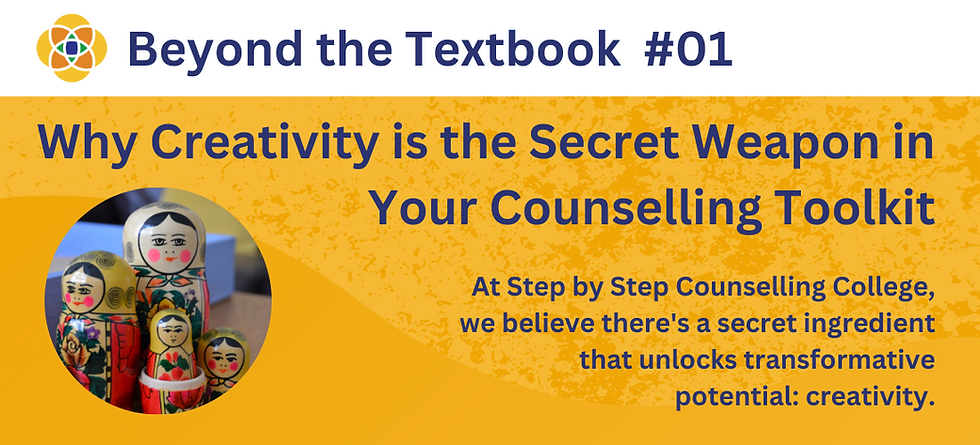Why Creativity is the Secret Weapon in Your Counselling Toolkit
- Step By Step Counselling College

- Jan 5, 2024
- 3 min read

In the world of counselling, emotions can run high as we support our clients’ exploration of often vulnerable experiences, and whilst as therapists we rely on the most valuable tools of empathy, listening, and ‘clinical’ knowledge, we believe there's another secret ingredient that unlocks transformative potential: creativity.
Creativity in counselling is not about painting masterpieces or strumming a guitar in session; it isn't about fluffy crafts or whimsical exercises. It's about using an open mind, breaking free from rigid formulas, and embracing a dynamic, client-centred approach. It's about seeing beyond the surface, tailoring interventions to individual needs, and unlocking hidden pathways to growth.
But how do you actually integrate creativity into your counselling practice? At Step by Step Counselling College, we believe in leading by example. That's why our curriculum is infused with innovative teaching methods and hands-on workshops that nurture your own creative spirit. We encourage you to explore the power of sand trays, working with objects, using pen, paints, and paper.
We encourage students to think outside the box: As they start to gain experience, we encourage experimentation with different techniques and interventions. In every room we have creative elements that students can use as they collaborate with their ‘clients’.
Being creative isn’t just about giving it a go though. It is an ongoing process that needs reflection, we encourage feedback – asking the ‘client’ and an observer to identify what worked well, and experiment with new approaches.
One of the biggest barriers to creativity for both the counsellor and the client can be just not feeling good enough”. Handing a pen to a client and inviting them to draw something can be hard for the client if they feel that they don’t have the ability to draw, so matching the technique to the client is important. For example, a poet or musician might want to share a piece of work, a dancer may want to move…. but there is also something in working at the edges of our comfort and of working within trust. Sometimes as therapists we work at the edge of our comfort zones (and as long as our client is held in a safe space that is ok) and at others, the client can be the one who is challenged.
So, how do we, at Step by Step, teach creatively and equip our future counsellors with this vital skill? We move beyond the textbook and embrace a dynamic, hands-on learning environment.
And it's not just about the techniques. We foster a culture of creativity in our college. We encourage open-mindedness, experimentation, and a willingness to step outside the box. One session we had some time ago, saw us inviting the students to draw a fish. One student in particular was very reluctant (“I can’t draw”, “What has a fish got to do with me?”), they had five minutes to draw the fish and anything else they wanted to add to the picture. Once finished they were invited to work in pairs for half an hour each to discuss their drawings. They came back completely changed! Whilst talking about the fish and its surroundings, they recognised where they were in their life.This connection with the subconscious, was incredibly powerful. The session, a revelation, all based on a picture of a fish by someone who ‘can’t draw’. It is a reminder that counselling is not a one-dimensional exercise in problem-solving. It's a journey of exploration, connection, and growth. By embracing our own creativity and integrating it into our practice, we can all unlock a world of possibilities for our clients (and ourselves).
Studies repeatedly highlight the positive impact of creative approaches in counselling. One study found that clients who engaged in creative activities like journaling or art therapy reported increased self-awareness, improved emotional regulation, and a greater sense of empowerment.
It can feel daunting (for the counsellor and client) to engage in a creative exercise and that is why we weave in creative elements to all our courses. We strongly believe that trainee therapists equipped with both clinical knowledge and a creative spark, will be able to support their clients in a more dynamic rounded way than if they just had theoretical knowledge.

Comments